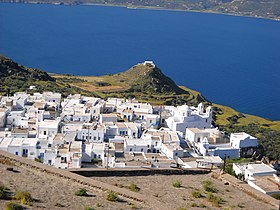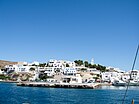Milos
Μήλος | |
|---|---|
| Coordinates: 36°41′N 24°25′E / 36.683°N 24.417°E | |
| Country | Greece |
| Administrative region | South Aegean |
| Regional unit | Milos |
| Seat | Plaka |
| Area | |
| • Municipality | 150.6 km2 (58.1 sq mi) |
| Highest elevation | 751 m (2,464 ft) |
| Lowest elevation | 0 m (0 ft) |
| Population (2021)[1] | |
| • Municipality | 5,302 |
| • Density | 35/km2 (91/sq mi) |
| Time zone | UTC+2 (EET) |
| • Summer (DST) | UTC+3 (EEST) |
| Postal code | 848 00, 848 01 |
| Area code(s) | 2287 |
| Vehicle registration | EM |
| Website | www |
Milos or Melos (/ˈmiːlɒs, -loʊs/; Modern Greek: Μήλος, romanized: Mílos, IPA: [ˈmilos]; Ancient Greek: Μῆλος, romanized: Mêlos) is a volcanic Greek island in the Aegean Sea, just north of the Sea of Crete. Milos is the southwestern-most island in the Cyclades group.
The Venus de Milo (now in the Louvre), the Poseidon of Melos (now in the NAMA) and the Asclepius of Milos (now in the British Museum) were all found on the island,[2] as was an archaic Apollo now in Athens. Milos is a popular tourist destination during the summer. The municipality of Milos also includes the uninhabited offshore islands of Antimilos and Akradies. The combined land area is 160.147 square kilometres (61.833 sq mi)[3] and at the 2021 census the population was 5,193 inhabitants.
- ^ "Αποτελέσματα Απογραφής Πληθυσμού - Κατοικιών 2021, Μόνιμος Πληθυσμός κατά οικισμό" [Results of the 2021 Population - Housing Census, Permanent population by settlement] (in Greek). Hellenic Statistical Authority. 29 March 2024.
- ^ "statue". British Museum. Retrieved 25 March 2019.
- ^ "Population & housing census 2001 (incl. area and average elevation)" (PDF) (in Greek). National Statistical Service of Greece. Archived from the original (PDF) on 2015-09-21.








